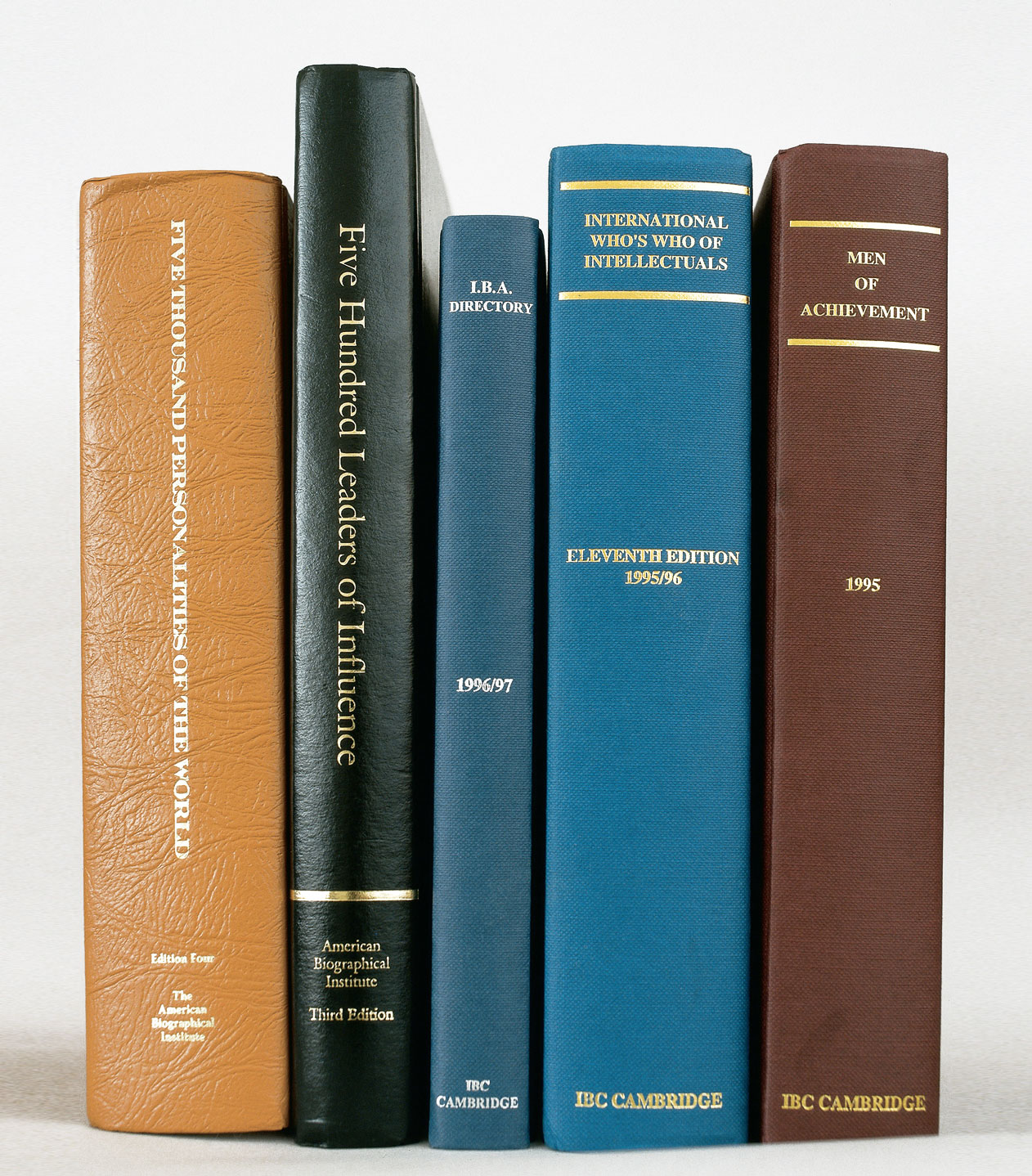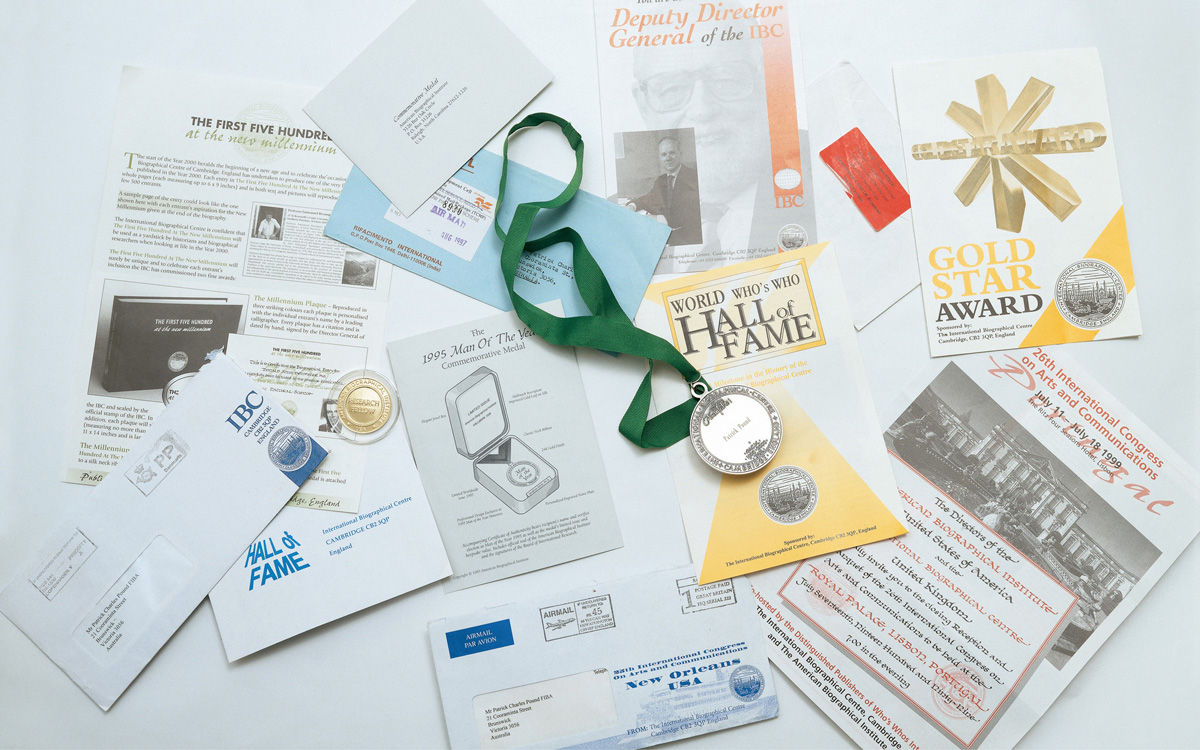Artist Project / C.V.—A Work in Progress
Almost famous
Patrick Pound

C.V.—a work in progress is a sort of covert operation. In the early 1990s, as an artist with a taste for little deceits and art crimes, I decided to “infiltrate” the worldwide vanity press system. This was to be an artwork, or a “home project,” undertaken as if by a character in a novel. I also liked the idea of an international project, undertaken at my little desk, that produced a vast range of artworks. Artworks I didn’t have to make. I had noticed that there were plenty of good artworks out there if only artists were prepared to buy them.
C.V.—a work in progress began as a parody of the growing artists’ mania for curricula vitae and the art world’s literal obsession with identity. Over a decade or so, the project evolved into a collection of awards that beggar belief. Each new addition was a new piece of evidence, a new piece in the puzzle. Slowly I was putting together a thoroughly false, and amusing, picture.
By continuing the project for so long, and at such expense, I was aiming for a saturation of stories; for a fiction convincing in its thoroughness, if not its facts. Gradually I inserted a variety of half truths and outright fabrications into this vanity system. I began carefully, with the inclusion of a false hobby or two (lepidoptera, rugby) and went on to credit myself with invented projects, such as the editing of a book of letters of a nonexistent author, or the setting up of F.A.F.—a society dedicated to the uncovering of Fakes and Forgeries.
By paying to become a Fellow of the International Biographical Association, I was “awarded the right” to adopt the letters F.I.B.A. after my name. Letters from the vanity press companies were then addressed to Patrick Pound F.I.B.A. With this award came a stamped, embossed identity booklet. The fictional wheel had come full circle.
The sales pitches for these awards are now themselves a vast collection. I have dossiers of thousands of pages of offers, an archive awaiting display as “Pitches at an Exhibition.” While the solicitations keep coming, late last year I called a halt to any further purchases from the procession of possible accolades. I closed the collection with a final sash and plaque when I became the International Artist of the Year for 2004.
My interest in fictional identities began in the early 1980s, when I faked a series of letters to the editor of a New Zealand newspaper. On one occasion, I succeeded in having 14 published in just two days; they were all regarding a music review and took all sides. Since 1989 I have written on and around my artwork under a collection of pseudonyms. Beginning with an ersatz interview in my first catalogue, Fragments and Fakes, I have affectionately parodied critical mannerisms, while saving money on author’s fees.
My pseudonyms include Monica Smith (Monica being a pun on moniker), Dr. Gerry Ford (Ford, Gerry—forgery), the curator Ian Smith Jr. (Ian Smith Jr. being the son of Ian Smith, that is, Smith’s son Ian, curator; that is, Smithsonian curator). Ray Fox is an allusion to Reynard the fox, that trickster of medieval marginalia. Under the name Simon Dermott, I have written several reviews of books, from Ralph Rugoff’s Scene of the Crime catalogue to a crime scene photographer’s guide. Simon Dermott was the specialist in museum security and the detecting, tracing, and exposing of forgeries from the film How to Steal a Million.
I am an artist working at the categories of things. Whether categorizing thousands of newspaper cuttings in albums by subject, or photographing people taking photographs, I am an artist who reads the world as an endless series of overlapping lists. From a collection of Lost Bird posters culled from the streets to a collection of early postcards of a single street I am copying the world in the form of the index. These works call into play the limits of description and the description of limits. From the collection of 365 unremarkable brown things, to twenty-six pieces of evidence lifted from my street and placed in bags, my work has the look of being made by someone who upon trying to explain the world, and having failed, has been reduced to collecting it.
If collection is consumption lived, then C.V.—a work in progress is a limit case. I have bought my way onto this ridiculous list and ended up with yet another collection for display.

Patrick Pound is a Melbourne-based artist. He is represented by GRANTPIRRIE Gallery in Sydney, Hamish McKay Gallery in Wellington, New Zealand, and Anna Bibby Gallery in Auckland, New Zealand, with whom he has an exhibition in August.
Spotted an error? Email us at corrections at cabinetmagazine dot org.
If you’ve enjoyed the free articles that we offer on our site, please consider subscribing to our nonprofit magazine. You get twelve online issues and unlimited access to all our archives.